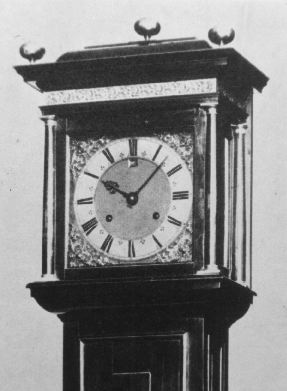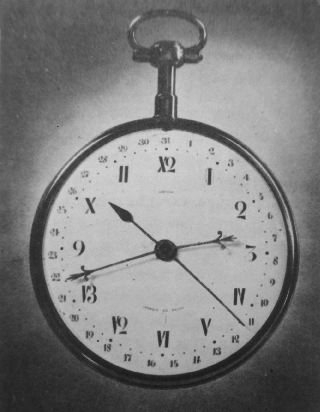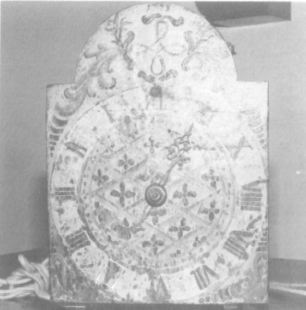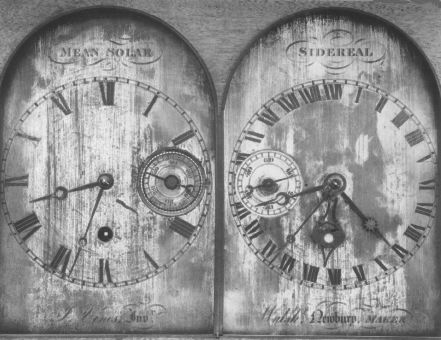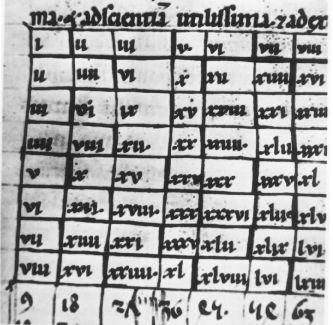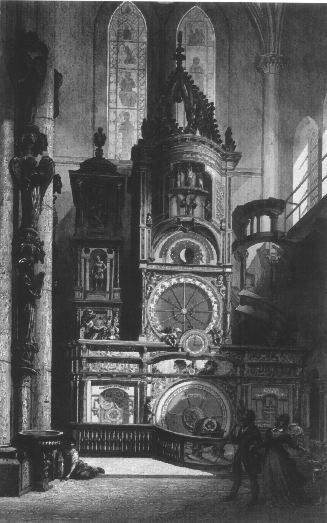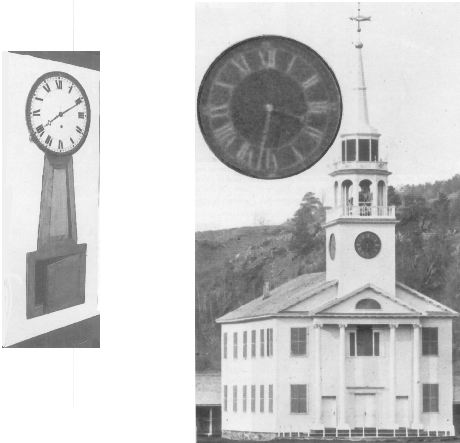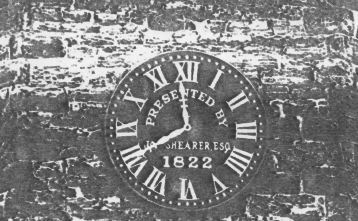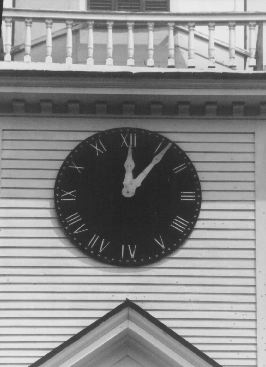that is the question:
© Donn Haven Lathrop 1996
With apologies to the Bard of Avon...but, should the 4 on a clock dial with Roman chapters be painted or engraved as IIII, or as IV? That is a question asked, and to date, 'answered' by many. Brooks Palmer seems to have started it off most recently with the unequivocal statement in the December, 1965, BULLETIN (#119, Pg. 91) that old clocks never had the IV form unless it was done "by someone who didn't know better". A running debate then commenced in the pages of the BULLETIN in which John Hueton (#123, Pg. 426) stated that the IIII form was pre-1820 because George IV (1820-1830) objected to being known as George IIII; at which point Geoffrey Buggins (#125, Pg. 640) wrote from England that the 1820 date is of no particular horological significance whatsoever, and that the IIII form is proper and necessary for balance against the VIII. Albert Odmark (#127, Pg. 878) noted that Joseph Knibb (1670-1711) used the IV
Figure 1. Knibb clock dial on a month-going tall-case
form on clocks which used the Roman striking system, and that the great French horologist Jean Antoine Lépine (1720-1814) occasionally used the IV form. Not only did Lépine use the IV, but he mixed Roman and Arabic numbers on the same dial; e.g.,V 2, for 7, V 3 for 8,
with Roman striking. Note the use of IV for 4.1
and X 2 for 12. Robert Wolf (#137, Pg. 683) sent in a photograph of an Act of Parliament clock of the mid-1700's---with an IV; Henry Fried (#160, Pg. 731) related one of the stories of the "King and IV", and Carol Buonato stated (#297, Pg. 453) that "The fourth hour, when done in roman numerals, is always done as IIII rather than IV."
Figure 2 The Lépine watch dial with mixed Roman and Arabic numbers.
But it isn't! Who's right? What is the proper form? And, is there an answer?
Somewhat of an answer to the question may come with a look at the origins of Roman numbers, whose lineage extends to at least the 7th century B.C. That's about two thousand years before the first mechanical clock woke its first sacristan to ring the first of the canonical hours--matins--so he and his brethren could say their first mechanically timed prayers at the proper time. Before the first alarm clock was invented, the sacristan had to hope the clepsydra (water clock) didn't run dry or freeze, or, if his monastery couldn't afford a clepsydra, he had to watch the stars and hope he could stay awake. Perhaps we can now understand why clocks were immediately so wildly popular!
The earliest numeration system with a distinct similarity to the Roman is considered to be that of the Etruscans, who flourished in Italy between the 7th and 4th centuries B.C., or until the Romans made them 'do as the Romans do.' They used numeral signs which resembled the letters of their alphabet as did the alpha/numeric signs later used by the Romans. Both
2
the Etruscans and the Romans used eitheror V for 5, and an X or an
for 10. Both of these number systems somewhat resembled that of the Hittites of Mesopotamia, whose day in the sun lasted from 2000 to about 700 B.C. The Hittite numeration system was a bit unusual:
while the Romans used this notation:
Take note of theand the VIIII and try them on a clock dial! The Italians did.
Figure 3. Italian dial with theand the VIIII.
Not only that, the hand moves counter-clockwise!
The IIII form is considered to have derived from the use of tally sticks on which a series of vertical lines were made to keep track of whatever was being counted or tallied. In other words, there is a logical reason for the IIII form, while the (much) later IV form appears to be an artificial (perhaps mathematical?) construct to satisfy someone's whim.
3
The vertical lines would indicate a count of 4, then a differentiation of some sort was used to indicate 5--this could be a slanted line next to a vertical line, as on these early tally sticks:
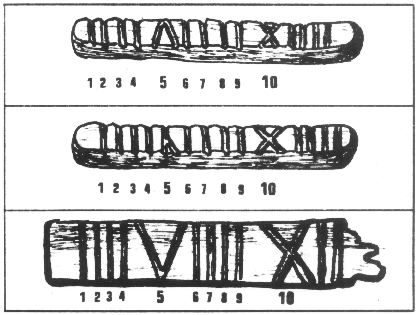
Figure 4. Examples of a tally stick. Note that the top one uses thefor 5,
the center one has a slanted line next to a vertical line,
and the bottom one uses the more familiar V,
while the two crossed slanted lines would indicate twice five, or ten. Note that the V for 5 could be, and was, either right side up or inverted, simply because V is half of X, as in. Both were used, seemingly without any problems in being understood. Theodor Mommsen, a German historian and philologist (historical linguist), in 1850 advanced the notion that V was a sort of hieroglyph representing the open hand with its five fingers, and two of these hieroglyphs yielded X, or 10. If this were the case, it would seem that any serious taking of inventory would have involved a good deal of hand waving. Perhaps the good Dr. Mommsen had noted that Mediterranean peoples tend to much gesturing as they talk.
While a dial with the narrow end of the V pointing away from the center of the dial may look odd to us, the Romans would have recognized it immediately. The IIII form apparently continued to be the preferred notation throughout the Republican and Imperial periods of the Roman domination of Europe. After the beginning of the downward spiral, in 1453, that eventually led to the collapse of the Holy Roman Empire1 Roman numbers became known as 'German' numbers, and were in common use until the 17th century. An interesting sidelight is the independent development of a numeration system, used through the nineteenth century by the Zuñi Indians of Southwest America, which is identical to the Roman numeration system. It also used the IIII form for 4. A tally stick--a wolf bone dating back to Paleolithic times, perhaps as far back as 35 ,000 BP (before [the] present)--was found in 1937 in Moravia. Another 10 ,000 year-old bone with faint scratches--apparently a tally stick of some sort--has been found in some other prehistoric midden, but the suspicion is that the 'tally' scratches were made by some beast of prey--keeping his own tally.
1 Voltaire wrote somewhat scathingly that "the agglomeration which calls itself the Holy Roman Empire is neither holy, nor Roman, nor an Empire.
4
A constant in early Roman numeration was the additive system, as in VIIII for 9, XII for 12, or XVIII for 18. However, possibly concurrently, but more likely much later, a subtractive subsystem evolved, which we see today in IV for 4, and IX for nine. This may have had its roots in the Etruscan notation--which was read from right to left--in which IV denoted 6. Roman numbers probably became a bit confusing to everyone. Earlier, I mentioned that the IV form could have been an artificial construct. The IV form will indeed be easier to read in a lengthy series of numbers, and will take up less room on the page. But, and this has always niggled at me, there is no logical reason for anyone to have developed the IV form other than to make it easier to read. In other words, IV is a bastard form, while the IIII form can trace its antecedents into the dim recesses of prehistory.
We are taught today that the additive LXXXIIII is 84, yet there is a Roman milestone from 130 B.C. on which 84 is shown as the subtractive/additive XXCIIII. The subtractive was rarely used in numbering by the ancient Romans, and very few instances of its use are found during the Middle Ages--that oddball milestone is singled out for mention in several scholarly texts on numbering systems. The English, in the 1286 accounts concerning the clock in old St. Paul's Cathedral--although the account is written in Latin--used the expression CCIIIIXXI to indicate 281. Could that be considered an additive/multiplicative system? Not until the middle of the fifteenth century do the documented first cases of the use of IX for 9 occur (by the French and the Piedmontese). By this time Roman numerals were so far removed from their origins that they should be more properly called 'German' numerals. We use today a hodgepodge of both the additive and subtractive systems.
Technically, in order to achieve agreement between the Roman numeration system and the spoken and written Latin, 12 would be IIX; i.e., duo decimo and 16 would be VIX, or sexto decimo. In other words, Latin (as does modern English), used an apparent subtractive principle in speaking, and the additive system in their numbers, except in their occasional use of duo de viginti, 'two from twenty' or 18, written IIXX; and unus de viginti , 'one from twenty' or 19, written as either XIX or IXX. Perhaps the IIII form is the proper one and lazy dial engravers and painters used the IV? I cannot find specific documentation of the first use of the IV form--all of the authorities consulted merely mention that the first use of the IV was noted in the Middle Ages--but it may well have been in France at about the same time the IX first appeared. The French seem to have been more horologically aware than the rest of the world; Abbé Bulteau wrote in his 1887 Monograph on the Cathedral of Chartres that mechanical clocks were invented in the 10th century in Constantinople! So much for Gerbert of Aurilliac (later Pope Sylvester II), who is sometimes credited with the first clock. Curiously enough, after the Pope invented his clock, he "[set] it by looking at the polar-star through a tube." Personally, I've never seen a transit telescope pointed at the North Star--it's somewhat difficult to judge when said star crosses a meridian. I would have to think that the 'clock'was a sundial.
5
Just out of curiosity, try IX (uno decimo , or eleven) and the above IIX on a dial, along with some of the other odd number constructions. But, in designing a dial, should you subscribe to the additive or the subtractive methods, or should you attempt to correlate the correct grammatical sequences with your chosen method? No matter what you try, the dial will never have the symmetry and balance that XII, VIII, and IIII yield--whether you deem that last correct or not. And how about mediæval Papal Bulls which used the symbol--for 8! Since idle hands are the devil's workshop, I drew a dial using the additive method, then the subtractive, and then tried a third based on the computational additive, but which also attempted to make the numerals agree with the linguistic sequence. Then one using the
... of which I must say, it was pure bull--Papal or otherwise.
Never mind what the dials looked like--but Lépine would have loved them. Perhaps I should refer the questioner to Eric Bruton's A History of Clocks and Watches.
Figure 5. The double dial clock made in
1836 by 'Walsh of Newbury.'
On page 227, there is a double dial clock made in 1836 by 'Walsh of Newbury'. The dial on the left shows 12-hour mean solar time, and uses the IIII form. The dial on the right? Well, it's a 24 hour dial indicating sidereal time which uses the IIII form for 4, the XIV form for 14, and the XXIV form for 24! I wonder if it was a striking clock, and did it strike 12 or 24? It was about this time that I began to sympathize with the worthy, motley fool of As You Like It , who:"...drew a dial from his poke,
and looking on it with lack-luster eye,
Says, very wisely, It is ten o'clock..."
6
Regardless of its cumbersome complexities, the Roman numeration system remained the official commercial system used throughout the Middle Ages, to the point that the use of any other system was strictly forbidden by law in 1300 A.D. The Hindu system (which was considered to be too easy to forge--a 0 could be easily changed to a 6 or a 9) invaded Europe via the Arabs (who lived in between). The Arabs were smart enough to see the advantages of the Hindu system, and spread it over the then known world in the wake of their religio/military campaigns. The Arabs somehow get all the credit for the 'Arabic' numeration system on the dial of your favorite pillar and scroll. However, 'tain't Arabic--it's Indian, and Gerbert, mentioned earlier, is credited with introducing Hindo-Arabic numerals to the Western world in about 980 AD.2 The system was finally accepted all over Europe by 1800, regardless of any earlier strictures. We do however, have to give the Arabs credit for the zero, and its use in positional notation. Robert Reichel wrote a short dissertation (#271, Pg. 165) on Which Came First, 10 OR X?, and Joseph Dean commented (#69, Pg. 556) on the history of 'Arabic' numerals.
But to continue with Roman numerals: In 1524, Jakob Köbel wrote a treatise on German mathematics--using Roman numerals. A sample:
Figure 6. Köbel's multiplication table. Note that he left out the column for 4.
Köbel even went so far as to express fractions in Roman numerals! Did you know that
Try looking for a least common denominator with that notation! Or try figuring out a wheel to pinion ratio from either XVI : LXXXXVI (additive method) or IIIIXX : XCVI (subtractive method), and in the same manner, compute the ratios all the way from the great wheel to the escape wheel. Alternatively, try using the ratio
355 or CCCLV
113 or CXIII
to compute the circumference of a circle using Roman numeral notation. The resultant of this ratio,355
113
is 3.14159, or π, and I cannot find any logical method anywhere to properly express and use π in Roman numerals. (Nor do I really want to.) Consider the 18th century merchant who asked a German professor of mathematics where he should send his son for an education in business. The professor replied that any student could learn addition and subtraction in a German university, but that to learn multiplication and division, said student should travel to Italy--which country had adopted the Hindo-Arabic system. Giovanni da Dondi used Arabic numerals on his 1348 astronomical clock, and a chamber clock with Arabic numerals appears in a 1406 French manuscript. If anyone is interested, there are algorithms which ease somewhat the seeming impossibility of multiplying LXII by XI, but we won't go into those.
2 Just to throw a figurative bucket of cold water on the glories of mediæval civilization, I must remind the reader that the Maya of Mesoamerica developed and used positional notation nearly 4,000 years before it was introduced in Europe.
7
Roman numerology also developed some other cryptic number symbols. In 1570, Conrad Dasypodius (literally, 'Rabbitsfoot') de Thurgovie, an eminent mathematician of the times, used the symbol ∞ to represent 1000, instead of the now more common M, when he rebuilt the monumental clock in the Cathedral at Strasbourg. The derivation of the ∞ was thought to be an X laid on its side, with the legs curved inward toward each other to avoid any possibility of confusing this sideways X with an erect X. Some authorities also consider this the symbol for 100,000, and we regard it as the Greek symbol for infinity. Mommsen considered the ∞ to be derived from the Greek φ (phi), to which was assigned the value of 1,000. φ was later written in three parts as in:, to represent 1,000;
then came to represent 400, and
represented 999. Sic transit gloria mathematica !
The first Strasbourg clock was "so complicated that no one could repair it when it finally stopped, and it was replaced by a new clock"--but the dial uses the IIII. Even though it has since been rebuilt at least once more, some parts of the original clock are said to be in the Strasbourg City Museum.
Figure 7. Strasbourg engraving, credit Reinhardt
8
There is an apocryphal tale which by now has acquired the veneer of truth, about Louis XIV (additive/subtractive, by the way) of France. He was the badly inbred 'Sun King' who started the War of the Spanish Succession in 1702 in the English Colonies because he wanted the Spanish throne for his grandson. The story is that a famous clockmaker (could it have been Lépine?) had made a clock for the King, and had 'naturally' (Maybe it isn't so apocryphal, after all. The French were the first to use the IX form.) used the IV form. When the king saw the clock, he remarked that IIII should have been used instead of IV, as IV was a part of his exalted name.
Another tale from the French (via the Grolier Encyclopædia): Henri de Vick made a clock for Charles V (also known as The Wise) and upon completing the clock showed it to the Emperor of the Holy Roman Empire who examined it carefully and pronounced himself satisfied with the mechanism. Upon examining the dial, the King told de Vick that he should not have used IV in place of the correct IIII. de Vick then changed the dial to accommodate the King's wishes. The article in the encyclopædia goes on to say:"In 1270 (sic) Henri de Vick made a clock for Charles V [of France]..." and "Thus began the custom of "IIII" on the clock..." and "...the use of "IIII" instead of 'IV' is due to a desire to avoid possible confusion with the 'VI' if one looks at the numbers upside down..."I would have to say that not only is this story apocryphal, it is wrong. The clock was erected in 1370, 100 years later. And how on earth is someone going to view the numbers "upside down" on a clock dial that is many feet above the pavement? And check out the below photograph of the dial. The alert observer will note in the below photograph of the dial it has carried the IIII form for 4 for the last six hundred and thirty eight years.
Figure 8. The dial of de Vick's clock on the Palace of Justice. When the clock was installed in 1370 the building was the Royal Palace.
Another story has it that King George IV of England, whose ten year reign ended in 1830, did not want to be known as George IIII, and decreed that IIII should disappear entirely from the English scene. Regardless, the IIII form is still very popular in England, and if we go back to the early Romans, the Etruscans, and even the Hittites, the IIII form has historical precedent, as well as the needed visual symmetry for our 12 hour clock dials. Many of the very oldest clocks in Europe which had 24 hour dials used the IIII form, even though there was no need to seek a symmetrical and visually appealing arrangement of the dial numbers.
Britten avers that Joseph Knibb invented and introduced the Roman method of striking for his month clocks--and always used the IV form on month clock dials--rather than the common IIII. In Roman striking, two bells of different pitches are used; a higher pitch for the I's, and a lower pitch for the V's. The lack of popularity of Roman striking may stem from the fact that when the clock strikes IV, it's 'Ding-dong', and two hours later, VI is 'Dong-ding'. A bit confusing, to say the least. To compound the confusion, Jesse Coleman wrote of a Swedish clock using Roman striking--but with 'Arabic' numerals on the dial!
Clockmakers in this country, among them, Sperry & Byram of Long Island, Austin Van Riper and Stone & Marshall of Cazenovia, New York, Abel Stowell, Sr. of Worcester, Massachusetts, and even Aaron Dodd Crane of Newark, New Jersey, used both the IV and the IIII forms on their tower clock dials. Examples are to be found throughout the pages of the horological literature. A recent article in the BULLETIN (#293, Pg. 723) on Stephen Hasham of Charlestown, New Hampshire, illustrates this rather well. (All of his ten known tower clocks used the IV form, as did his double-dialled, between-the-wall 'banjo' clock).
9
Figure 9. On the left, Stephen Hasham's through-the-wall banjo clock. Note the IV on the dial. On the right, the Norwich, Vermont, Congregational Church with its 1816 Hasham tower clock. The inset clearly shows the IV form on the original dial.
A tallcase by Hasham in the New Hampshire Historical Society Collection, however, uses the IIII form. Some dial makers have used the "proper" IIII form, but made the edges of the strokes of the numerals radial to the center of the dial. Even though Shakespeare wrote in King Henry IV : "As many lines close in the dial's centre", radial strokes still look rather odd.
Figure 10. The dial of the Pittsfield, Massachusetts, Town Clock, with its severely radiused numerals. This dial is known to be the fourth or fifth reconstruction of the dial, so we can't blame the maker, Stephen Hasham of Charlestown, New Hampshire. Besides, he always used the IV form on his tower dials.
I caught the sign maker who painted this dial just before he was about to paint four new dials laid out in a similar manner, for another church. Those four new dials will have no "lines closing in the dial's centre", and now grace the church steeple, properly. Then there's the dial on a church in New Hampshire which nearly made me drive off the road:
10
Figure 11. This dial on a church in Lyme,New Hampshire, not only has the V, VI, VII, and the VIII upside down, but also has the VI, VII, and the VIII backwards.
and that of a small electric banjo I picked up at a Mart, simply because of the dial. It would have given Brooks Palmer fits!
Figure 12. The Sessions banjo, with a dial done "by someone who didn't know better."
Lord Grimthorpe may have been right. His opinion (and he had--and expressed--opinions on everything!) was that no numbers were necessary at all, just strokes of an appropriate width. The dials for the Great Clock in the Victoria Tower of the Palace of Westminster in London seem to have no numbers at all (I'd been told by many people they're just carefully contrived strokes), but a careful examination will reveal Roman numerals on the dials--and the IV form at that! It may be that we have been doing dials all wrong all along, and we should all be more like Samuel Butler's Hudibras, who could:"...wisely tell what hour o' the day
The clock does strike, by algebra."
I was quite positive that the ancients were consistent in their use of the 'correct' IIII form--didn't Brooks himself say so?--but got shot down by the IV form on a 1486 tower clock in Prague, Czechoslovakia, (with a 24 hour dial, to boot)
Figure 13. The 1486 clock in Prague, with IV form--twice. Note also the early Arabic numbers on the outer chapter ring.
in conjunction with early Arabic numerals. (A short, unattributed paragraph in the BULLETIN, [#48, Pg. 388] claims that Arabic numerals first made their appearance on watch dials in 1785.) An engraving purporting to show Henri De Vic at work in the 14th century clearly shows two IV'ed dials above his workbench. Successive appearances of the IV form, for which I can find documentation, occur in the 1300's, mid 1500's, mid-1700's, early 1800's, and of all places, on an early box clock by Eli Terry--in the Book of American Clocks! Brooks Palmer suggested that his correspondent (mentioned above) check out the photographs in Prof. Willis Milham's Time and Timekeepers, for "authenticated clocks of the world with Roman dials..." in support of his contention that only the ignorant used the IV form. Well, on page 512 of Time and Timekeepers is the clock at Prague mentioned above, with an IV--twice--on its 24-hour dial.
Figure 14. A very early, possibly experimental, Terry box clock with
outside escapement. Note the IV form on the reverse painted glass dial.
I think I can safely say that this question, of whether to IV or not to IV, will continue to arise in the future, as new members of the NAWCC start wondering whether to IV or not to IV. After digging through all my research materials, it seems most probable that the widespread use of the IV form began during the 14th century in France. As Professor 'enry 'iggins said, "The French really don't care what you do, as long as you pronounce it properly!" A 1388 French document exists which used 'IIIIXX et huit', for 88--is this a 'combinative' system? Baker's Arithmetic of 1568 introduced another method--the coefficient--in which the expression "four Cli.M" represents 451,000. Even with all of these various methods at hand, as well as the theories propounded in many scholarly dissertations on number systems, I cannot solve the puzzle posed by the unique use of Roman numerals in the 1463 will of John Baret of Bury St. Edmunds. His bequest [to the church] was for the upkeep of the steeple chimes and another set at St. Mary's altar which played Requiem æternam , and was "to contynuwe with the same song tyl my xxxti day be past for me." xxxti?---thir-tee-one?
Abel Stowell, Sr., of Worcester, Massachusetts, the first maker in this country to adapt the French flatbed design for tower clocks, used the IV form on the dial of his Hubbardstown, Massachusetts tower clock in the late 1700's. It's probably mere coincidence, but his apprentice, Stephen Hasham, used the same flatbed design and the same IV form rather consistently.
Conclusions? Perhaps. Sort of. Maybe. The IIII form is the proper one for a visually balanced and appealing twelve hour dial with Roman numerals, and if one wishes to do as the Romans probably did, IIII is the correct way to write IIII. However, dial designers are going to continue to do pretty much as they please, just as they have for at least the last IV hundred years, and some poor soul will send another plaintive question to the perceived current authority. The answer will be either an absolutely definitive (possibly 100% wrong or 100% correct) statement, or another apocryphal tale. IIII is the only Roman numeral construct to be used for a visually balanced dial. As I said earlier, in other words, IV is a bastard form, while the IIII form can trace its antecedents into the dim recesses of prehistory. QED.
Regarding numbering systems, (and this is totally off the wall) isn't it strange that no one has ever designed a clock dial using the Maya notation? The disputes over the correct arrangement of their bar/dot/glyphic notation could rage on for years!
If you have a few spare hours, here's the Maya notation; 1 to 12. Bear in mind that the number symbols are read from bottom to top, and may be oriented as they are, or tilted 90 degrees to the left, or 90 degrees to the right. Also bear in mind that the Maya had no known concept of seconds, minutes, or hours. Their primary concern was numbering the days of their year(s) (both past and future), to which end they had three different lengths for their years. And you only have until 2012 to design your dial. That's the ending date for the current calendar round, and some say, the end of the world!
In any case, as to the resolution of the debate over IIII and IV, perhaps Desdemona's comment in Othello has the right of it: "O, most lame and impotent conclusion!"Ø
11
Bibliography:
BRITTEN'S OLD CLOCKS and WATCHES AND THEIR MAKERS (Ninth Edition): Ed., G. H. Baillie, Courtnay Ilbert, & Cecil Clutton: Bloomsbury Books, London, England. 1986.
BULLETIN of the NAWCC, Whole Numbers 119, 123, 127,Vol. XII; & 137, Vol. XIII: Columbia, Pennsylvania.
BOORSTIN, Daniel J., The Discoverers: Random House, New York. 1983.
BREARLEY, Harry C., Time Telling through the Ages: Doubleday, Page & Co., New York. 1919.
BRUTON, Eric, The History of Clocks and Watches: Rizzoli International Publications, New York. 1979.
CAJORI, Florian, A History of Mathematical Notations: The University of Chicago Press, Chicago. 1928.
CAPELLI, Adriano. Dizionario Di Abbreviature latine ed italiane: Tipografia Sociale (S.A) Milano, Italy. 1929
HUMEZ, Alexander, HUMEZ, Nicholas, MAGUIRE, Joseph, Zero to Lazy Eight: Simon & Schuster, New York. 1993.
IFRAH, Georges, From One to Zero: Viking Penguin Inc., New York. 1985.
MENNINGER, Karl, Number Words and Number Symbols: a cultural history of numbers: Translation by Paul Broneer. The M.I.T. Press, Cambridge, Massachusetts. 1969.
MILHAM, Willis I. Ph. D., Time & Timekeepers: The Macmillan Co. New York. 1923.
REID, Constance, From ZERO to INFINITY: Thomas Y. Crowell Co. New York. 1955.
REINHARDT, Hans, La Cathédrale de Strasbourg: Imprimé en France; B. Arthaud. 1972
ROBERTSON, J. Drummond, The Evolution of Clockwork: Cassell & Co. London. 1931.
SHELLEY, Frederick M., Aaron Dodd Crane, An American Original: Supplement to the BULLETIN of the NAWCC, Columbia, Pennsylvania. 1987.
SWETZ, Frank J. Ed., From Five Fingers to Infinity: Open Court Publishing Co., Chicago, Illinois. 1995.
Return to Page Three of the late Donn Haven Lathrop's three main pages.
Compare Donn's original version of this page if it still exists.
To comment on this page, please
